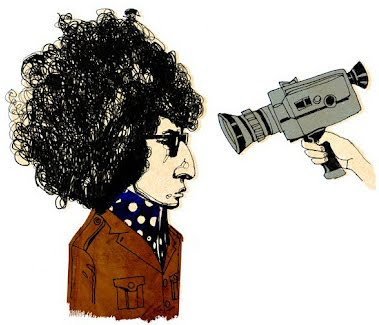The beautifully executed artwork of Michael Gillette is, simply put, absorbing. Michael marries drawing and painting skills with an aesthetic underpinned by a love of popular culture, most specifically music. His sly sense of humor and artistic style creates haunting, cerebral work that isn’t easy to categorize. Never one to follow conventional paths, he was kicked out of art school in England for refusing to see the difference between graphics and illustration (it probably didn’t help matters that he was caught using the school’s printers for his own band’s album cover art). For the last 20 years he has been brilliantly visualizing the unreasoning vibrations of music, working with Elastica, Beck, The Beastie Boys, MGMT, and Paul McCartney to name a few.
Currently I am fortunate enough to collaborate with Michael on his monograph, appropriately titled “Drawn in Stereo”, to be published in 2013. In the meantime, here’s my Q&A with the inimitable Michael Gillette.
Job description: Artist.
Why do you do what you do? When I was a kid I fell in love with drawing and the way it made me feel, and there has been nothing that has come along since that has been as enjoyable so here I am.
How do you break through a creative block? I trust that creativity is a natural state. If there is something blocking it- that it is me. So, I try to figure out why and how I'm doing that. I used to do the Artist Way morning papers, where you write down your stream of consciousness. That has helped. I try and keep a very keen ear to whatever bullshit I might be thinking and nip it in the bud because I I know full well the ditches that lie either side of the highway. I wrote this to remind myself of some pitfalls which block creativity.
Education: I went to a British art school, so I consider myself almost entirely self taught. Thank the lord for the Public Library system of San Francisco.
Mentors: Roger Law is probably the closest person I have to a mentor. He was an illustrator in the 60’s, then went on to helm a satirical T.V. show which evolved around the caricature puppets he made. Now he’s a heroic ceramicist. We email sporadically, but he's always been a very generous and supportive person and I really dig him. He’s a force of nature and he keeps making work that is is plugged in and openhearted with a sly sense of humor.
World-saving mission: hah! I’m trying to save myself.
Office chair: I have a Aeron chair which I bought when I first moved to San Francisco, it was just after the dot bomb, so you could walk in to empty offices full of them and buy them on the cheap. I’ve recently switched back to an armless Knoll Pollock, the arms on the Aeron kept bumping in to my desk.
Office Soundtrack: BBC Radio 2,3,4 & 6 KCRW, Dunwich Radio.
Most useful tool: My brain.
Favorite space: I really love the inside of the Chapel At Sea Ranch. Actually all of Sea Ranch is aright by me, I love the Rec centres too. My wife describes it as communism for rich people.
Favorite design object: 1965 Epiphone Casino.
Guilty Pleasure: I don’t believe in Guilty Pleasures— if something is enjoyable, fair enough, I’m done being cool.
Underrated: Intuition.
Overrated: Technology.
What did you learn the hard way? That everybody is making it up as they go along, so there is no reason to feel insecure.
Has your work ever got you into trouble? Not since I was caught drawing an unflattering portrait of my French teacher on a rainy day in 1983.
If you could cross over into other profession what would you do? I always wanted to be a musician, or some kind of performer, but I’m happy making art, I’d like to do so more autonomously.
Dream project: I have an idea for an animated show which I’d love to see happen
Where’s home? Currently it’s very much San Francisco, I love this city so much, but I'm probably in the later days of being here, but I won’t stray far. California is really part of my mindset. I still have feelings for Wales where I grew up and am grateful that I got to live there too.
“The Little Angels” is an ongoing series of simple watercolours depicting recently deceased stars in the prime of their childhood. “The criteria is that the stars must have died at an early age, and the images must capture them before they are cognizant of their own image. My hope is that the sweet nature of the pictures and the tragedies that link them will invite the viewer to question both our obsessions with stardom, and the belief that fame is a cure all,” says Michael.
Beck for the his album “The Information”. Jean Michel Basquiat for the LA MOMA.
Bob Dylan from “Music Listography” published by Chronicle books.
“At home with Charity” painting for an exhibition.
“Happy Place” experimental work.
Video animation stills for the “Beastie Boys 5 Boroughs” album.

Dum Dum Girls, personal work.
Tommy Lee for Spin magazine.

B is for Beatles, for an illustrated alphabet exhibition in Dublin curated by Print Process.
Personal work.
“Drive” poster and cover for the film magazine, Little White Lies.
The 3 Disgraces, cover for Centerfold magazine.
A sampling from Michael’s sketchbook.
A possible cover for Michael’s book, “Drawn in Stereo” coming in 2013.





















































